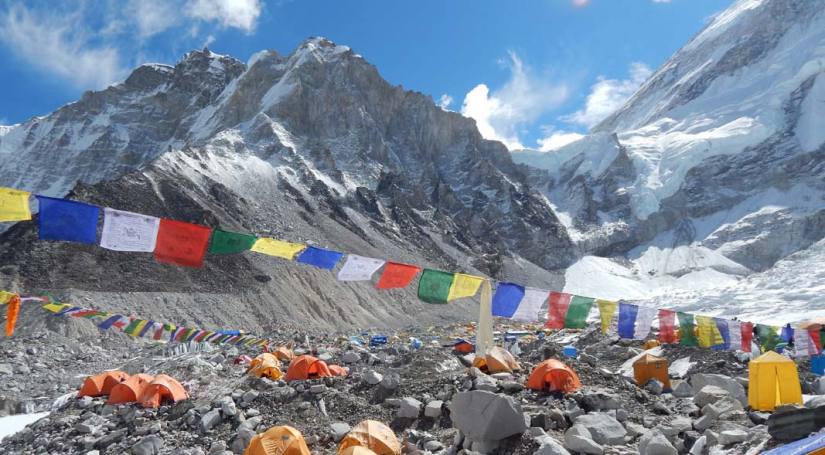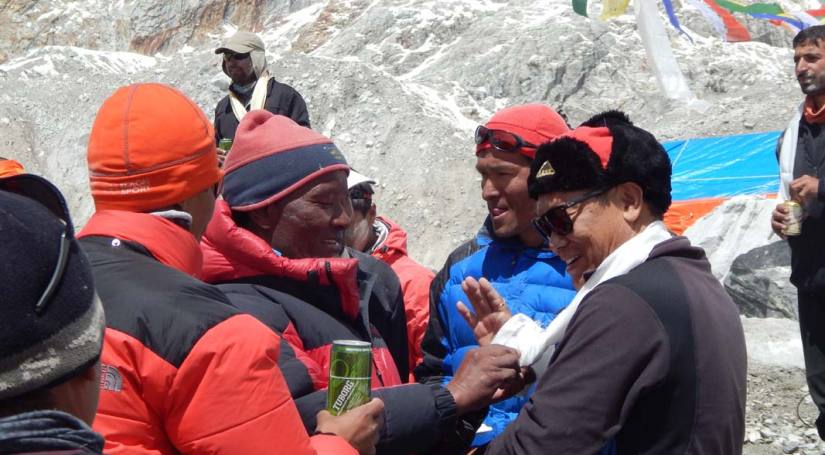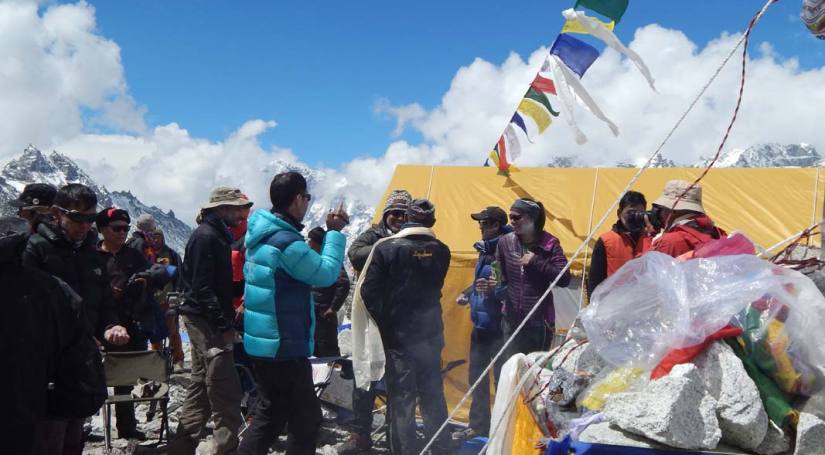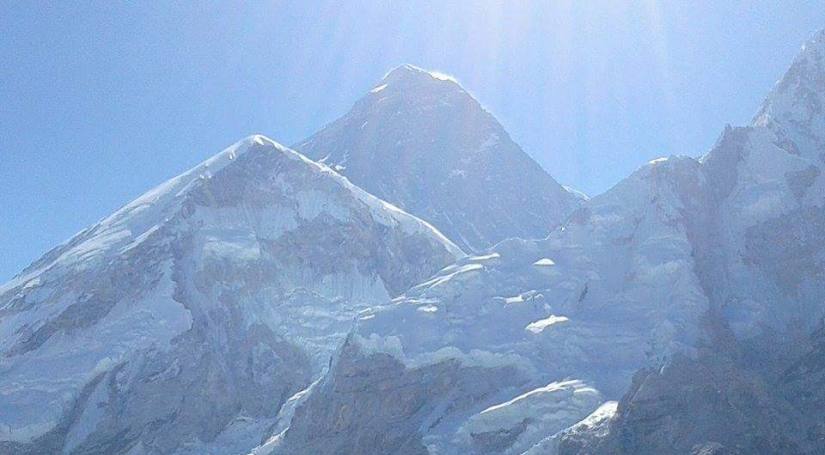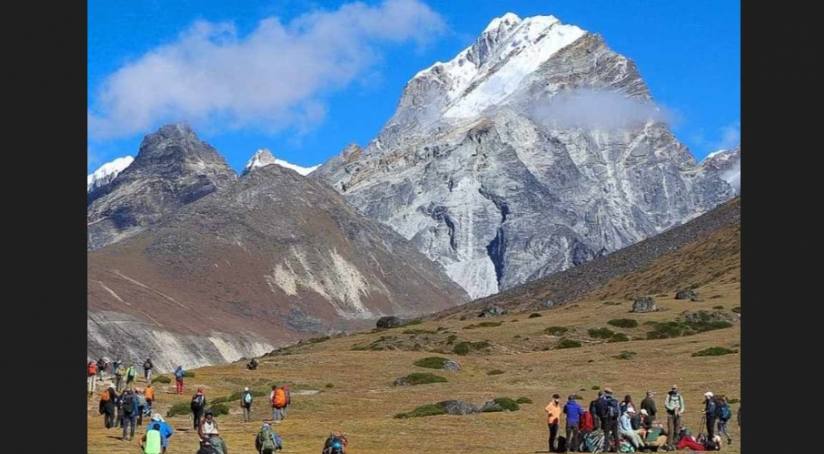Mt. Everest Expedition-8848.86m (60 Days) Nepal South Side, Full-Board Services - 2025 April-10th - 60 Days
-
Trip Code HTA-19
-
Duration: 60 Days
-
Trip Grade Moderate
Trip Highlights
- Attempt to summit the highest peak, Mount Everest
- Spectacular view of all the Himalayas in Nepal
- Experiencing the traditional culture of Sherpa people and their hospitality
- Buddhists monasteries in the foothills of the mighty Himalayas
- Grandest walk in the Land of Himalayas
- A short visit to the world heritage sites in Kathmandu as well
About Trip:
Mt. Everest climbing has proved to be a benchmark of climbing achievement. The mountain receives around 600-700 summit attempts every year. Everest can be climbed both from the southern side of Nepal and the northern side of Tibet. After the Cultural Revolution in the 1950s, China closed the Tibet borders to outsiders and Nepal began welcoming foreigners to the Everest Region. Since then, the southern approach to the mountain via the Khumbu Valley has become popular among climbers. Mt. Everest was first summited in 1953 by Tenzing Norgay Sherpa and Edmund Hillary via the South Col. Climbing Mt. Everest is certainly a lifetime opportunity. However, these days Everest expeditions is conducted from both the north and south side and have encountered many seen, and unseen obstacles including high altitude, harsh weather conditions, and even sheer exhaustion. Therefore, we strive hard to conduct the best expedition program putting high importance on the safety aspects of the climb. As we all know it is getting heavily commercialized these days but we prioritize safety by focusing on the proper acclimatization process by doing an additional above 6000m peak(lobuche east) right before the expedition to prevent many rotations in the dangerous Khumbu icefall & by providing top senior most experienced sherpas if you can help us in the early confirmation process.
Outline Itinerary
Day 01: Arrival in Kathmandu & transfer to hotel-1300m/4264ft
Day 02-03: At leisure in Kathmandu
Day 04: Fly to Lukla & Trek to Phakding - 2,840m/9,315ft
Day 05: Trek to Namche Bazar
Day 06: At leisure in Namche Bazar
Day 07: Trek to Tyangboche or Dibuche
Day 08: Trek to Dingboche
Day 09: Acclimatization
Day 10: Trek to Lobuje
Day 11: Trek to Lobuje Basecamp (4,940m/16,210 ft.)
Day 12: Rest Day at Lobuje base camp
Day 13: Ascent to Lobuje high Camp (5,400m/17,712ft)
Day 14: Lobuje Summit (6,119m/20,070 ft) and back to base camp
Day 15: Trek to Gorakshep (5,170 m/16,961ft)
Day 16: Trek to Everest Base Camp
Day 17-19: Rest and preparation
Day 20-53: Ascent of Mt Everest
Day 54: Withdraw to Base Camp
Day 55: Return to Tyangboche or Dibuche
Day 56: Return trek to Namche Bazaar via Dinboche and Thyangboche
Day 57: Trek to Lukla
Day 58: Fly Lukla to Kathmandu
Day 59: Free Day in Kathmandu
Day 60: Fly Back Home
Cost Includes:
- Expedition permit fees for Everest & lobuche east.
- 5 nights’ accommodations in Kathmandu with bed and breakfast facility.
- Flights from Kathmandu to Lukla and back including airport transfers.
- All overnight accommodations while on the trek and climb.
- Climbing equipment for group like ropes, snow bar, ice screw, etc. which are necessary.
- 5 oxygen bottles (each of 4 liters) per member and 4 oxygen bottles per sherpa; 1 bottle of oxygen lasts for 5/6 hours.
- Set up regulator mask of high quality for member and Sherpas.
- Liaison officer by government with his equipment, wages, insurance, and all his facilities.
- Equipment transportation by yaks or porter and means of transportations (like helicopter etc.)
- Communication services i.e., walkie-talkie.
- Services of kitchen, dining with tents which are required in the base camp, toilet tents, heater, (per member:1 tent till base camp and sharing above base camp) (cook service till base camp and camp 2)
- Insurance, equipment, rescue facility and daily wages of Sherpas and Nepalese kitchen staffs with good experienced cook with necessary Nepalese kitchen staffs.
- Helpful and Experienced Climbing Sherpas for member (at-least summited multiple times Everest before. including other mountains as well.)
- Rope Fixing Entire Team To the Summit(With Equipments required and carry bonus from base camp to summit.)
- Solar power
- Welcome Dinner
- Rope fixing team for expedition
- High foods above base camp and high cooking pots, EP gas, and other necessaries.
Cost Excludes:
- International airfares to and from Nepal.
- Lunch and Dinner while in Kathmandu
- Nepal Visa fees
- Member's Travel and rescue insurance
- Extra expenses by member like Laundry fees, drinks, phone calls, shower, etc.
- All foods and beverages other than on the itinerary.
- Personal gears and equipment.
- Good Tips for guides, porters and drivers
- 1500 US$ per Sherpa as summit bonus
- Services more than included in “Trip Includes” section.
- Insurance and Trip cancellation
- No credit facility(Banks charges are applied to member)
Trip Map
Day 01: Arrival in Kathmandu & transfer to hotel-1300m/4264ft
Upon your arrival in the Kathmandu airport, you will be greeted by a representative of Himalayan Traverse. You will be then transferred to your hotel. After check in, you will meet your guide as well as other participants and do final preparation for the trip.
Day 02-03: At leisure in Kathmandu
Sightseeing and Preparation for Everest Expedition. While the leader attends a formal briefing in the Ministry of Tourism, you will explore the fascinating city of Kathmandu. Take rest, familiarize, and make a sightseeing tour to Kathmandu's World Heritage Sites. We make a guided tour to some of UNESCO World Heritage Sites in the Kathmandu valley: Kathmandu Durbar Square, Pashupatinath, Swayambhu, and Boudhnath. The day will also be for finalizing official procedure and other necessary arrangements. You will be also briefed on the nature of expedition, equipments and team composition. You can also make your last-minute buying of personal items as you will be flying to the Himalayas tomorrow. In the late afternoon, the leader will check everyone's equipment, as Kathmandu is the last opportunity to buy anything missing. You will also get introduced with fellow expedition members and guides. Later in the evening there will be a welcome dinner which will introduce you to the Nepalese food culture.
Day 04: Fly to Lukla & Trek to Phakding - 2,840m/9,315ft
An early morning scenic flight to Lukla. The mountain flight over to Lukla is one of the most beautiful air routes in the world culminating in a dramatic landing on a hillside surrounded by high mountains peaks. In Lukla, we will meet our camp staff and porters. After meeting our other crew members and with some packing and arrangements, we start our trek through the prosperous village of Lukla until we reach Phakding. Phakding lies on the main trade route through the area and there are a number of clean well-built lodges where we can spend the night.
Day 05: Trek to Namche Bazar
Continue up the banks of the Dudh Kosi, crossing it twice by small suspension bridges before reaching the village of Monjo where we will enter the Khumbu National Park. Cross the confluence of the Dudh Kosi and the Bhote Kosi on a high suspension bridge and climb steeply for about two hours to reach Namche Bazaar. This is a prosperous trading town and the capital of the Khumbu region with genuine Tibetan artifacts.
Day 06: At leisure in Namche Bazar
We spend a day in Namche Bazar resting and allowing our bodies to become acclimatized to the altitude of 3,450m (11,300ft). Although a leisure day, it's important not to remain idle. Health experts always recommend us to stay active and moving during the rest day too instead of being idle. We either spend the day taking a day hike to Thame or visiting Khunde or relaxing and exploring Namche Bazaar itself. Namche Bazzar is the main centre of the Everest (Khumbu) region and has government offices, ATMs, Internet cafes, shops, restaurants, a bakery and a colorful market each Friday evening and Saturday. If we trek a few hundred vertical feet during the day, it will help us to properly acclimatize. Our guides will take us to the Tourist Visitor Center near the headquarter of the Sagarmatha National Park where we can observe an assortment of things related to the first Everest ascenders, Sherpa culture and learn about the various plant and animal life of the Everest region.
Day 07: Trek to Tyangboche or Dibuche
The well-worn Everest trail contours around the side of the valley high above the Dudh Kosi. Follow the path, savoring the first really good views of the great peaks of the Khumbu: Everest, Lhotse, Nuptse and Ama Dablam. Passing by several villages and numerous tea shops, cross the Dudh Kosi River and make a steep climb to Thyangboche, home of an impressive and newly rebuilt monastery.
Day 08: Trek to Dingboche
We pass through several Chortens and Mani walls and small villages. We enjoy lunch with fantastic close-up views of Ama-Dablam. Shaded by rhododendron trees, the path leads gradually down to the river once again to another airy suspension bridge. An hour's walking from here brings us to Pangboche, an excellent viewpoint for Ama Dablam. Contouring up the valley side, re-cross the river and turn up the Imja valley to reach the picturesque farming village of Dingboche.
Day 09: Acclimatization
This is an important phase of the expedition. Dingboche is a good location for acclimatization. The team leader will organize daily outings to the adjacent hills with the aim of providing gradual acclimatization. Walk some of the nearby hills in order to slowly increase exposure to altitude. Follow the regime that you have previously found most suitable, in order to give you maximum acclimatization before arrive in base camp.
Day 10: Trek to Lobuje
Retrace back to Pheriche before continuing up the trail towards base camp. Reach Dugla situated below the snout of the Khumbu Glacier, a convenient place for lunch. After lunch, the trail starts steeply to climb up beside the glacier moraine. After a couple of hours, the track eventually leads to a small cluster of tea houses pleasantly situated at Lobuje.
Day 11: Trek to Lobuje Basecamp (4,940m/16,210 ft.)
This day we move to lobuje base camp from lobuje for the ascent of the mountain.
Day 12: Rest Day at Lobuje base camp
This is an extra day set aside to manage any unintended hindrances like flight delays or bad weather for climbing. Setting aside an extra day will ensure that even if we were to face a day's set back, the trip will continue thus guaranteeing a successful climb. Pre-Climb Training: Our guides will provide training on peak climbing techniques and the proper ways of using climbing gears such as the ice axe, climbing boots and crampons, harness, ascender, etc. The training will also include using ropes to go up and down. We strongly believe that the training experience will boost your confidence and climbing skills to increase the chances of scaling the summit as well as to fully enjoy the experience.
Day 13: Ascent to Lobuje high Camp (5,400m/17,712ft)
From Lobuche, we trek towards Lobuche base camp. After walking some distance on relatively flatter plane, the path to the Lobuche Base Camp gets steeper and rocky. We move forward along the Lobuche Glacier while enjoying great views of Ama Dablam, Cholatse, Pokalde, Thamserku, Kantega and other Himalayas. From the base camp, we continue on a rocky moraine path to reach the High Camp. After reaching there, we set up our camp, take lunch and rest. For the climb, we usually will be climbing on rock surface for up to around 5770m. After that, we climb on ice and use ropes when necessary. However, the use of the rope and the length depends upon the season and the crevasses. Fixed rope is used most of the times whereas man rope is used when required. The climbing leaders will decide what is best for when. Overnight in Lobuche East High Camp.
Day 14: Lobuje Summit (6,119m/20,070 ft) and back to base camp
We wake up early today at around 12 to 1 am and have our breakfast before beginning our climb. It is important we reach the summit before noon because in the afternoon the strong winds in the high lands might become a barrier for a successful summit. We will most likely be walking on rock surface up to around 5700m after which we climb on ice. We use both fixed rope and man rope as per our leader’s instruction. The climbing surface as well as the length of the rope and depends on the time of the season and the crevasses. Lobuche East offers more panoramic views of the mountains than any other trekking peak. From the summit, you get to enjoy magnificent views of Everest, Lhotse, Nuptse, Ama Dablam, Cholatse, Pumori, and many more. We spend some time at the summit celebrating and taking pictures, then we get back to the High Camp then base camp again for an overnight stay.
(Note: The reason behind the lobuje ascent is to decrease the up and downs by the khumbu icefall as its abit risky there by doing the acclimatization in lobuje. If we don’t do the lobuje ascent then we from Everest base camp do the camp 1(18,300ft.) overnight then to reach camp 2(20,000ft) the other day, finally back the Everest base back which will be for the acclimatization. But incase lobuje is done then we do camp 1 overnight for a day, camp2 overnight 3/4 day... in which camp 3(21,300ft) touch is done then camp 2 overnight then camp 3 overnight. Finally, back base camp (This makes 1st course cleared) for the final summit target.)
Day 15: Trek to Gorakshep (5,170 m/16,961ft)
This day we move from base camp to Gorakshep and overnight there.
Overnight in Gorakshep.
Day 16: Trek to Everest Base Camp
Contouring along the valley-side and looking down on the Khumbu Glacier, follow a reasonable trail to Gorak Shep. This was the site of the base camp in 1953 and now consists of a few small tea houses. Leaving Gorak Shep, the trail leads on to the moraine of the Khumbu Glacier and becomes quite vague, weaving between mounds of rubble and eventually reaching base camp near the foot of the Khumbu Icefall. This will be our home for the next six weeks.
Day 17-19: Rest and preparation
Day 20-53: Ascent of Mt Everest
Day 54: Withdraw to Base Camp
All team members return to base camp and assist with packing expedition stores and cleaning the base camp area.
Day 55: Return to Tyangboche or Dibuche
Day 56: Return trek to Namche Bazaar via Dinboche and Thyangboche
Day 57: Trek to Lukla
Day 58: Fly Lukla to Kathmandu
We will return to the Hotel. We need to take rest of the day.
Day 59: Free Day in Kathmandu
Day 60: Fly Back Home
This is the biggest expeditions in Nepal and it is only organized for Spring. So the trip must be confirmed before 6 months for further bookings and paperwork which is a long process and we have to send the name list in Government system and also for experienced Sherpas which are very much necessary for the trip. All paperwork must be done before April. A four-liter bottle of oxygen generally works for 6 hours.
Thank you.
You May Also Like
- Kanchenjunga Expedition (8,586m./28,169ft.)
- Mt. Lhotse Expedition
- Mt. Makalu Expedition
- Annapurna I Expedition (8,091m./26,545ft.) -Full-Board.
- Mt. Everest Expedition Nepal South Side & Lhotse- Full Board Services(April-5th)
- Mt. Dhaulagiri Expedition (8,167m/26,795ft)
- Mt. Manaslu Expedition August-29th(Full-board)
Trip Info
Trek to Langtang
We first met Dorjee Sherpa in 2012 and did a trek with him to Langtang before it was devastated in the earthquake. We quickly fell in love with the himalayas, the Nepalese people, their culture, and Dorjee shepa. The Langtang trek was a beautiful trek and a great introductory to the…
 Matt massey, United StatesApril 26, 2025
Matt massey, United StatesApril 26, 2025
Trek to Tyangboche
Just got home from our second trek in the Himalayas with Dorjee sherpa. We treked to tengboche for the mani rimdu festival. The festival was incredible and the mountains are magnificent. Dorjee is a great guide and we really enjoyed staying at his Buddha lodge and meeting his wonderful family.
 Matt massey, United StatesApril 26, 2025
Matt massey, United StatesApril 26, 2025
Mani Rimdu Festival trek
My family and friends from Maui completed a 10 day trek through Sagarmatha National Park to Tengboche to view the Mani Rimdu Festival in November . Our Guide Dorjee Sherpa and his associates arranged a fantastic trip for us. We stayed at his Buddha Lodge in Phakding and were treated very…
 Kevin Horan, NepalApril 26, 2025
Kevin Horan, NepalApril 26, 2025
Have fun with trust!
I spent very memorable days in the Everest region in Nepal. I used to dream to see this highest peak of the world and now I arrested it in my camera. My guide arranged everything and helped me a lot. He did not let me feel tired and boring.
 Austin, Netherlands AntillesApril 26, 2025
Austin, Netherlands AntillesApril 26, 2025
Certificate & Partners





